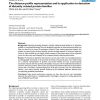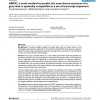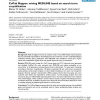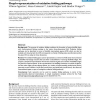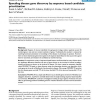BMCBI
2005
13 years 11 months ago
2005
Background: Phages, viruses that infect prokaryotes, are the most abundant microbes in the world. A major limitation to studying these viruses is the difficulty of cultivating the...
BMCBI
2005
13 years 11 months ago
2005
Background: In a previous report (La et al., Proteins, 2005), we have demonstrated that the identification of phylogenetic motifs, protein sequence fragments conserving the overal...
BMCBI
2005
13 years 11 months ago
2005
Background: Detecting homology between remotely related protein families is an important problem in computational biology since the biological properties of uncharacterized protei...
BMCBI
2005
13 years 11 months ago
2005
Background: Searching for approximate patterns in large promoter sequences frequently produces an exceedingly high numbers of results. Our aim was to exploit biological knowledge ...
BMCBI
2005
13 years 11 months ago
2005
Background: Currently available methods to predict splice sites are mainly based on the independent and progressive alignment of transcript data (mostly ESTs) to the genomic seque...
BMCBI
2005
13 years 11 months ago
2005
Background: High throughput microarray analyses result in many differentially expressed genes that are potentially responsible for the biological process of interest. In order to ...
BMCBI
2005
13 years 11 months ago
2005
Background: Proteins carrying twin-arginine (Tat) signal peptides are exported into the periplasmic compartment or extracellular environment independently of the classical Secdepe...
BMCBI
2005
13 years 11 months ago
2005
Background: Periodic phenomena are widespread in biology. The problem of finding periodicity in biological time series can be viewed as a multiple hypothesis testing of the spectr...
BMCBI
2005
13 years 11 months ago
2005
Background: The process of oxidative folding combines the formation of native disulfide bond with conformational folding resulting in the native three-dimensional fold. Oxidative ...
BMCBI
2005
13 years 11 months ago
2005
Background: Regions of interest identified through genetic linkage studies regularly exceed 30 centimorgans in size and can contain hundreds of genes. Traditionally this number is...

